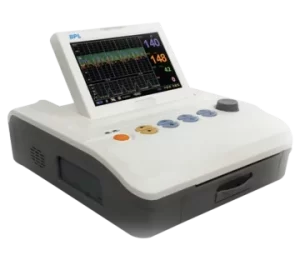
Fetal heart rate monitoring is a method used to track the fetal heart rate during pregnancy and labor. There are two main types of fetal heart rate monitoring devices: external and internal.
External fetal heart rate monitoring devices are typically used during labor to monitor the fetal heart rate. They use ultrasound to detect the fetal heart rate, and typically involve a belt or other device placed around the mother’s abdomen. Some external fetal heart rate monitoring devices also use cardiotocography (CTG), which uses electronic sensors to track the fetal heart rate and uterine contractions.
Internal fetal heart rate monitoring devices are used during more complex or high-risk pregnancies and can provide a more continuous and accurate assessment of fetal well-being. They involve a thin, flexible probe called a fetal scalp electrode being inserted through the cervix and placed on the fetal scalp. This device directly measures the fetal heart rate and provides a more continuous assessment of fetal well-being.
It’s important to note that fetal heart rate monitoring is just one aspect of prenatal care, and it’s not a guarantee of a healthy pregnancy outcome. Other factors such as prenatal testing, proper prenatal care, and close monitoring of maternal and fetal health can also play a role in a healthy pregnancy. Your healthcare provider can help you understand the best approach for fetal heart rate monitoring during your pregnancy.
What are the 2 methods of monitoring fetal heart rate?
The two main methods of monitoring the fetal heart rate are:
- External fetal heart rate monitoring: This method uses ultrasound to detect the fetal heart rate, and typically involves a belt or other device placed around the mother’s abdomen during labor. Some external fetal heart rate monitoring devices also use cardiotocography (CTG), which uses electronic sensors to track the fetal heart rate and uterine contractions.
- Internal fetal heart rate monitoring: This method involves the insertion of a thin, flexible probe called a fetal scalp electrode through the cervix and placed on the fetal scalp. This device directly measures the fetal heart rate and provides a more continuous assessment of fetal well-being, typically during more complex or high-risk pregnancies.
External fetal heart rate monitoring (EFM) can be performed using a variety of devices, including ultrasound, cardiotocography (CTG), and fetal Doppler.
- Ultrasound: An ultrasound device uses high-frequency sound waves to create images of the fetus and surrounding tissue. The fetal heart rate can be monitored by visually inspecting the ultrasound image or by using specialized software to track the heart rate.
- Cardiotocography (CTG): CTG uses electronic sensors to track both the fetal heart rate and uterine contractions. It typically involves a belt or other device placed around the mother’s abdomen, which is connected to a monitor that displays the fetal heart rate and contraction patterns.
- Fetal Doppler: A fetal Doppler is a handheld device that uses ultrasound to detect the fetal heart rate. It’s a portable alternative to CTG and can be used in a variety of settings, including the hospital, birthing center, or home.
It’s important to note that while EFM can provide valuable information about the fetal heart rate, it’s not a guarantee of a healthy pregnancy outcome. Your healthcare provider can help you understand the best approach for fetal heart rate monitoring during your pregnancy.
Fetal heart rate monitoring is typically started in the later stages of pregnancy, usually after 24 weeks. The timing of fetal heart rate monitoring can vary based on a number of factors, including the pregnancy’s overall risk profile, the mother’s medical history, and any previous complications or concerns during the pregnancy.
In low-risk pregnancies, fetal heart rate monitoring may not be performed until labor has begun. In high-risk pregnancies or in cases where there are concerns about fetal well-being, fetal heart rate monitoring may be performed earlier and more frequently, potentially as early as 20 weeks gestation.
It’s important to discuss the timing and frequency of fetal heart rate monitoring with your healthcare provider, as they can provide guidance on the best approach for your individual situation.
The purpose of fetal heart rate monitoring is to assess the well-being of the fetus during pregnancy and labor. By monitoring the fetal heart rate, healthcare providers can get a sense of how the fetus is doing and detect any potential issues that may require intervention.
During pregnancy, fetal heart rate monitoring can be used to assess fetal growth and development, monitor for changes in fetal activity, and identify any patterns or changes in the fetal heart rate that may indicate distress or other problems.
During labor, fetal heart rate monitoring is used to assess the impact of contractions on the fetal heart rate and detect any signs of fetal distress. In cases where fetal distress is detected, healthcare providers can take action to try to improve the fetal outcome, including delivering the baby if necessary.
It’s important to note that fetal heart rate monitoring is just one aspect of prenatal care, and it’s not a guarantee of a healthy pregnancy outcome. Other factors such as prenatal testing, proper prenatal care, and close monitoring of maternal and fetal health can also play a role in a healthy pregnancy. Your healthcare provider can help you understand the best approach for fetal heart rate monitoring during your pregnancy.

